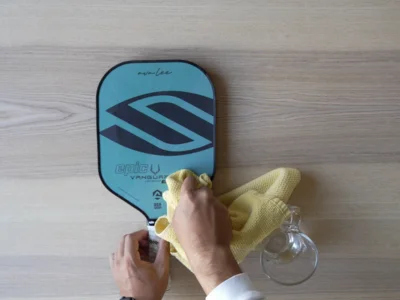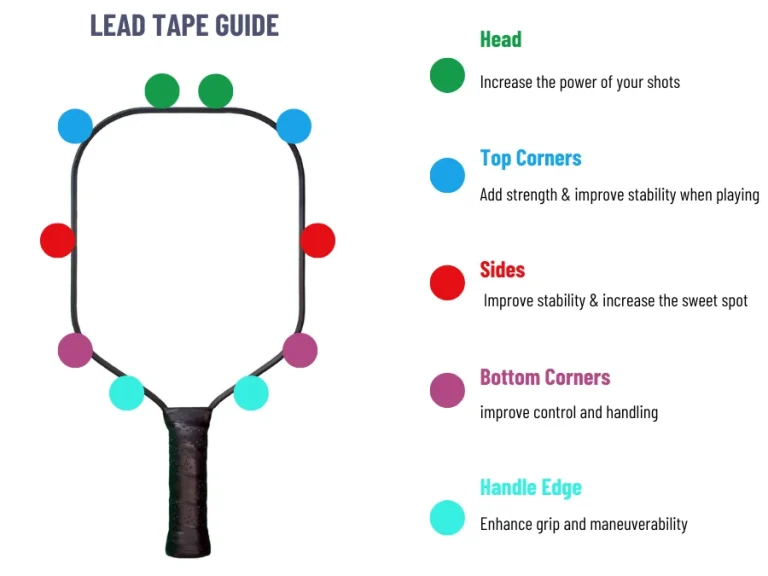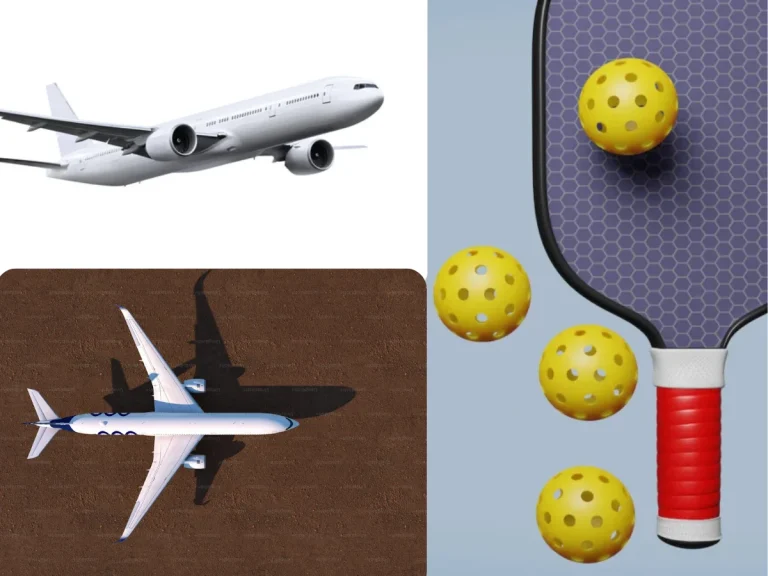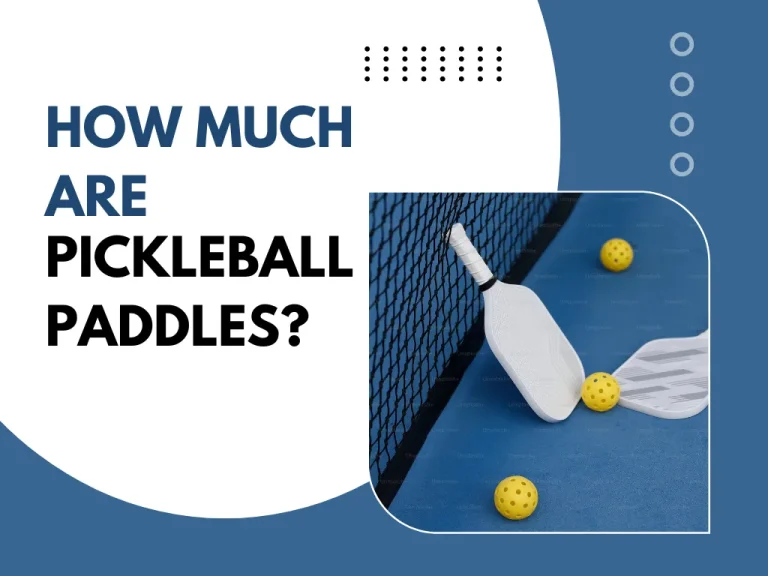Pickleball – the sport that combines tennis, table tennis, and badminton – is rapidly developing into a trend worldwide. Pickleball is a popular sport for participants of all ages because of its straightforward regulations and fierce competition. But how can you locate a good pickleball court?
This article will provide information on where can you play pickleball in your surrounding area, ranging from public parks, lawns, beaches, and so on to professional sports fields. Every kind of court surface has pros and cons and unique characteristics. No matter where you live or your skill level, you’ll find many opportunities to get on the court and join the pickleball craze.
Our Rating Standard
- Ideal: Perfect for pickleball, offering the best playing experience.
- Good: Suitable for pickleball, though with minor drawbacks.
- Fair: Playable, but with some significant limitations.
- Poor: Not recommended for pickleball due to major issues.
- Unsuitable: Not suitable for pickleball at all.
Types of Surfaces for Playing Pickleball
Wondering where can you play pickleball? Pickleball on natural surfaces is a one-of-a-kind and fascinating experience. The game is more enjoyable and connects with ecosystems in the open air and natural surroundings. Pickleball courts are available for use outside on natural surfaces, including driveways, beaches, artificial turf, concrete, asphalt, and clay.
So, where can you play pickleball? Each of these surfaces provides a distinct playing experience and influences gameplay in different ways.
| Surface | Can You Play Pickleball On This Surface? | Rating |
|---|---|---|
| Grass/Articicial Turf | Yes | Fair |
| Concrete | Yes | Good |
| Asphalt | Yes | Good |
| Cement | Yes | Good |
| Clay | Yes | Fair |
| Driveway | Yes | Fair |
| Beach | Yes | Poor |
Can You Play Pickleball On Grass/Artificial Turf?
Rating: Playable, but grass can be uneven, affecting ball bounce. Artificial turf is more consistent.
As for the question of whether pickleball can be played on grass, the answer is “Absolutely“. Both grass and artificial turf surfaces are suitable for pickleball, though with different playing conditions. These surfaces offer a softer, more forgiving texture than standard hard courts.
Grass offers a softer, more forgiving surface that can reduce impact on players’ joints. But it can be uneven, which changes the ball’s pace and bounce. In contrast, artificial turf offers a more consistent and durable surface. It enables a more predictable ball bounce and a more consistent playing experience. Both are popular for their pleasant aesthetics and natural feel.
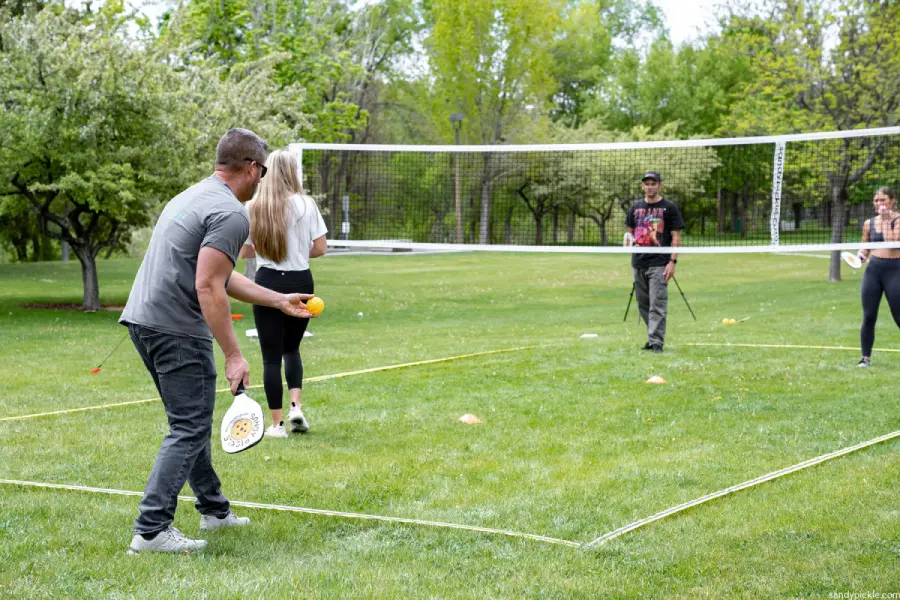
Can You Play Pickleball On Concrete?
Rating: Provides a firm, consistent surface with predictable bounces but can be hard on joints.
It is possible to play pickleball on a concrete court, of course. Concrete surfaces are commonly used for outdoor courts, offering a durable and stable playing area. Concrete creates a flat, sturdy surface that allows for predictable and consistent ball bounces. Players may move quickly and the ball reacts right away, providing a dynamic and entertaining playing experience.
But concrete’s hardness might sometimes work against you. The effect on players’ joints can be profound, increasing their risk of injury and increasing their level of weariness during prolonged play sessions. You may wear supportive shoes and use cushioned court shoes to mitigate this issue.
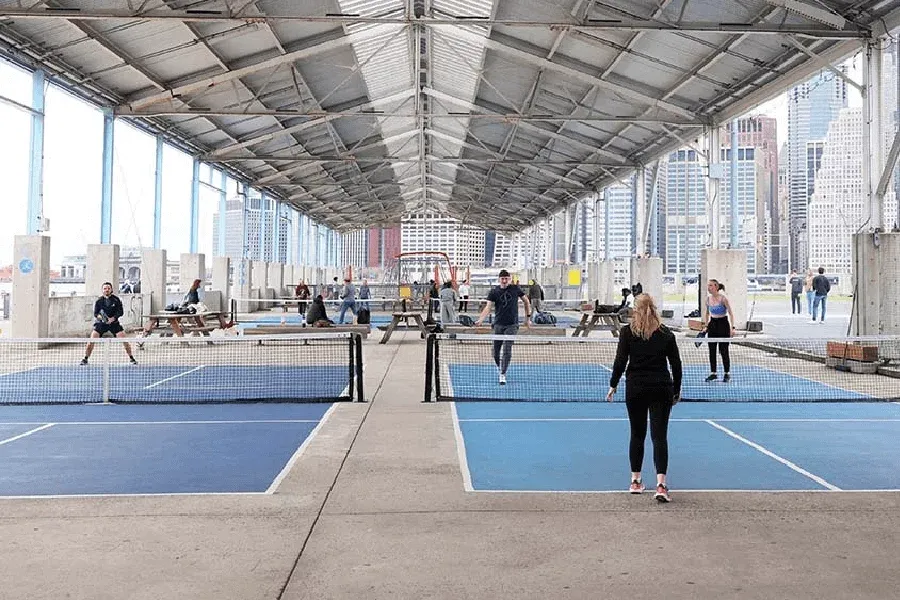
Can You Play Pickleball On Asphalt?
Rating: Similar to concrete, offering a fast-paced game, but can become hot and affect play.
Sure, you can play pickleball on asphalt. They are widely used for pickleball courts, even for outdoor recreational areas and community sports facilities. From the perspective of design, they are like concrete and offer a firm, level playing field that is perfect for a fast-moving game. The asphalt’s hardness makes it possible for the ball to move around the court swiftly. Thanks to that, this surface benefits players who like to play fast and aggressively.
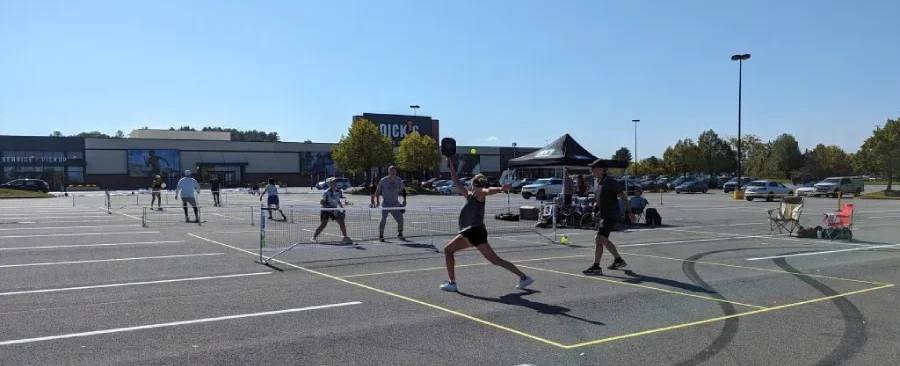
Can You Play Pickleball On Cement?
Rating: Durable and predictable, but harsh on joints and can get hot in warm weather.
Certainly, playing pickleball on cement is indeed possible. Cement courts are popular in outdoor settings due to their durability, low maintenance requirements, and inexpensive construction costs. Because of the smoother movements and fewer surprise bounces made possible by the level surface, it is simpler to predict the ball’s trajectory.
But there are drawbacks to playing on cement as well. The hardness of the surface could make sprains, strains, and discomfort from impacts more likely. Wet cement surfaces can also turn slick, which is dangerous. Furthermore, cement courts can get uncomfortable and heated in hot weather. This can have an impact on ball performance and player comfort.
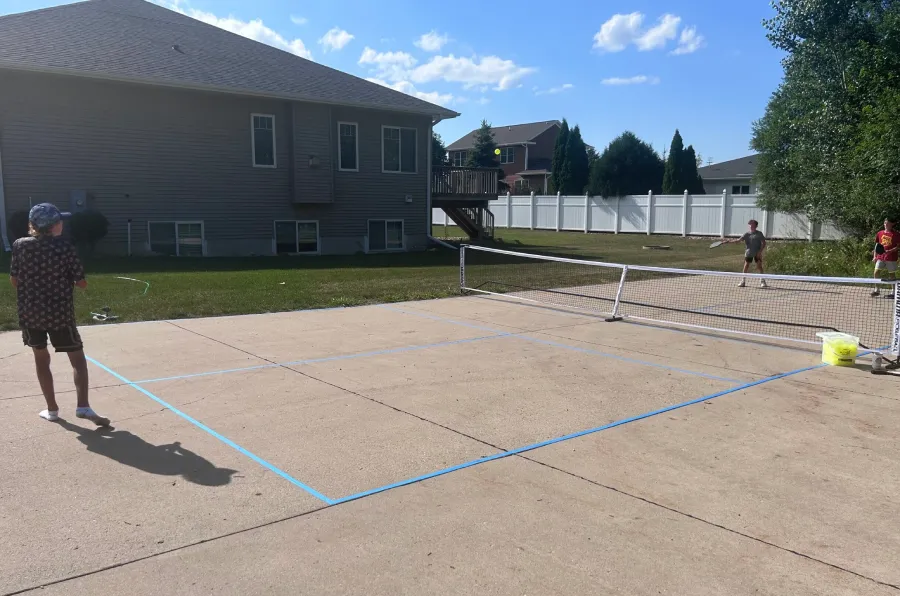
Can You Play Pickleball On Clay?
Rating: Softer and more forgiving, but slows down the game and can cause footing issues.
Although it is less frequent than on hard surfaces like concrete or asphalt, pickleball may be played on clay courts. Clay surfaces offer a softer, more forgiving surface than concrete or cement. This means the ball will bounce lower and slower, giving players more time to react and rally. Because of its softness, it might be a more comfortable choice for players who have cartilage issues or for prolonged play sessions.
Besides, the softer surface might lead to less solid footing. This leads to an increasing danger of ankle twists or other injuries if players are not cautious.
Can You Play Pickleball On A Driveway?
Rating: Convenient and accessible, but quality depends on the surface condition and size.
Sure, a driveway can be used for pickleball. For individuals who wish to practice their game close to home without the need for a dedicated court, this is an easy and accessible choice. Yet not all driveways are appropriate for playing sports.
- A smooth, even surface allows for consistent ball bounce and reduces the risk of tripping or slipping.
- Conversely, a driveway with cracks, potholes, or uneven sections can disrupt play, increase the likelihood of injury, and make the game less enjoyable.
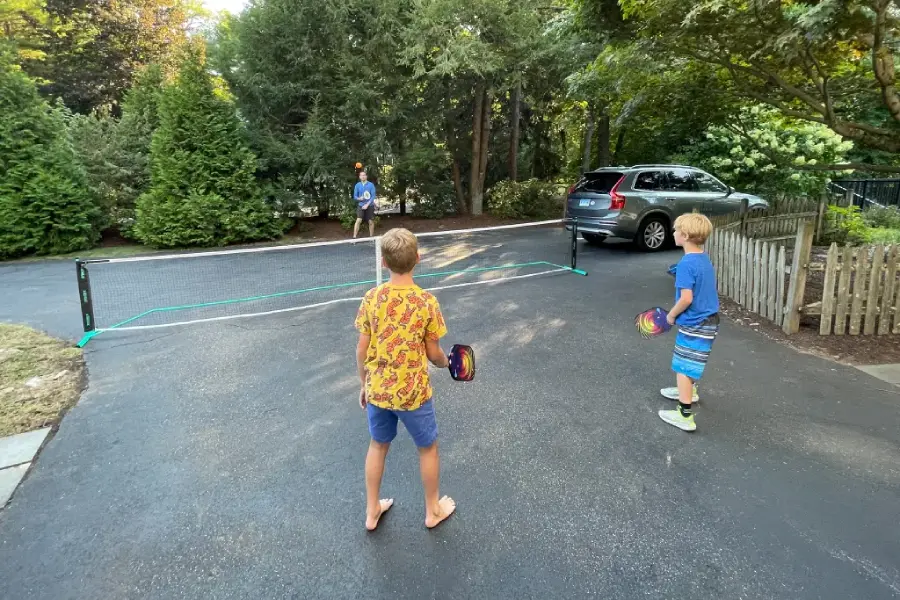
Can You Play Pickleball On The Beach?
Rating: Fun but challenging due to inconsistent ball bounce and difficult movement in the sand.
Sure, you may play pickleball on the beach as an alternative to traditional court surfaces. It can be an enjoyable and different approach to enjoying the game. Beach pickleball is a variation and it significantly alters the dynamics of the game. The soft, uneven sand alters how the ball bounces. As a result, it is less consistent and lower than on hard surfaces. The sand also slows mobility, making it more difficult to rapidly reach the ball or perform fast-paced rallies.
The uneven surface raises the danger of ankle injury. Additionally, the game tends to go more slowly, which could turn off some gamers. Furthermore, playing in the sun and wind can provide new obstacles like glare, sunburn, and unpredictable ball trajectories.
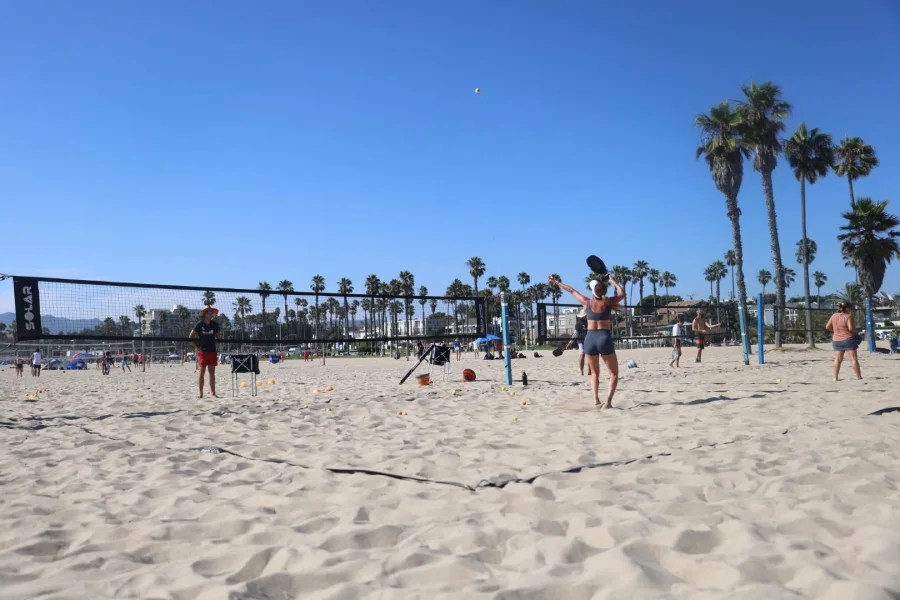
Is It Safe to Play Pickleball in Bad Weather?
Pickleball becomes more difficult when played in inclement weather, such as heavy rain or wind. Although these circumstances may heighten the excitement of the game, they also present potential safety risks and have a substantial impact on gameplay.
Rainy Weather/Wet Court
This is not recommended to play pickleball in the rain or play in a wet court because it comes with risks and safety concerns. Wet courts are slippery, significantly increasing the risk of falls and injuries.
Besides, a wet ball tends to absorb moisture, which can decrease its bounce and speed. Moreover, rain can hinder visibility, making it difficult to track the ball and judge the ball’s trajectory.
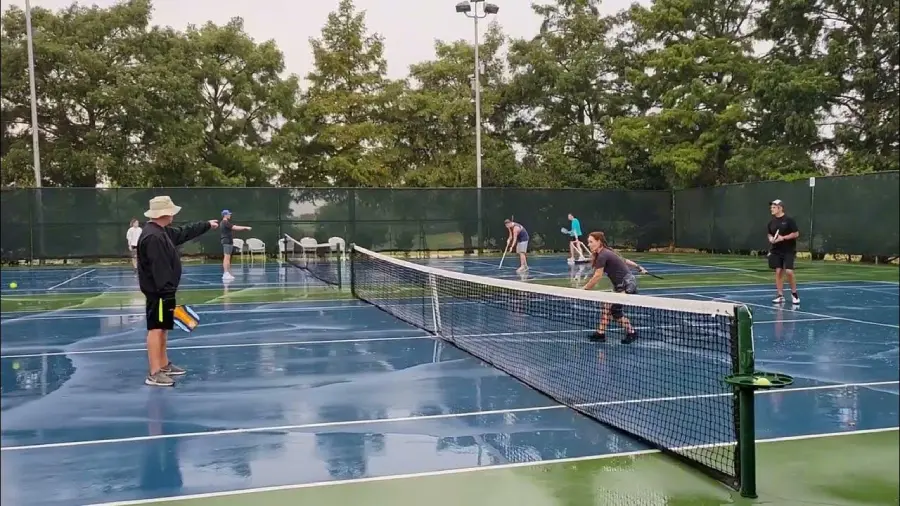
Windy Weather
Pickleball can be played in windy situations but this is an unusual and difficult experience. A blustery day can make it difficult to manage the ball and predict where it will go, which makes the sport more difficult.
Playing pickleball in windy weather has a distinct set of difficulties. The ball drops faster in the headwind direction and travels farther in the tailwind. Movement and posture on the court are also affected, as players must constantly react to changing ball routes and change their stance to maintain control. If you want to raise the level of the game, you can play in the wind. To control erratic ball movement and continue playing effectively, more concentration, flexibility, and smart corrections are needed.
Can You Use Other Sports Courts for Playing Pickleball?
Pickleball often shares space with other sports like tennis, padel tennis, basketball, racquetball, and badminton. The surface and markings of the court, however, might not always be ideal for pickleball.
| Court | Can you play pickleball on this court? | Rating |
|---|---|---|
| Tennis court | Yes | Good |
| Padel Tennis court | Yes | Good |
| Basketball court | Yes | Fair |
| Racquetball court | Yes | Fair |
| Badminton court | Yes | Fair |
Tennis Court
Rating: Suitable with minor adjustments like lowering the net and adding pickleball lines.
You may play pickleball on a tennis court, and it is a popular activity. Pickleball may be played on tennis courts with few changes. A tennis court’s usual dimensions are 27 feet wide by 78 feet long. Meanwhile, a typical pickleball court measures 44 by 20 feet.
Pickleball on a tennis court requires a few modifications. The tennis net must be lowered to the appropriate pickleball height (34 inches in the center). Pickleball lines need to be added to the court, as pickleball court dimensions are smaller than the standard tennis court dimensions. Gaining extra knowledge about the differences between tennis and pickleball helps you better adapt the court and improve your game.
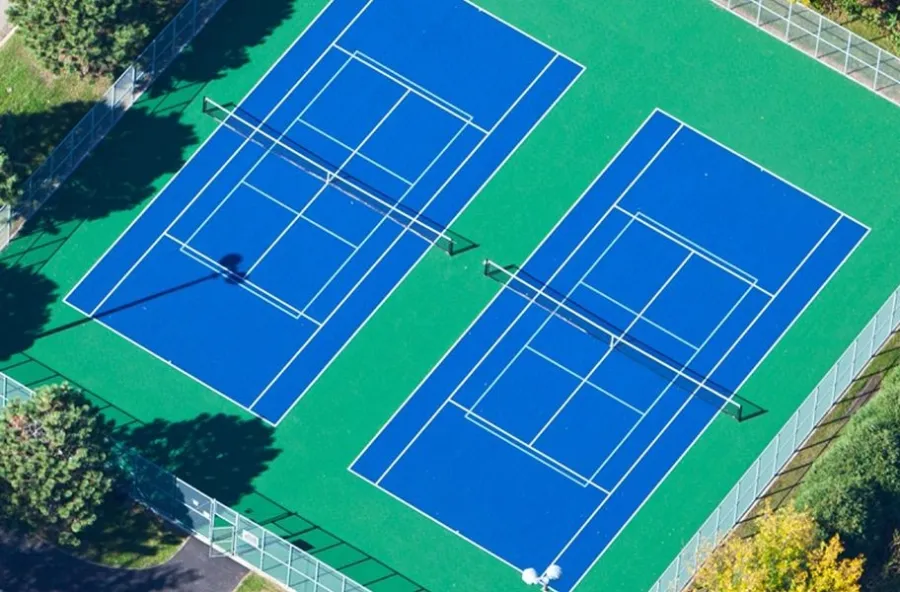
Padel Tennis Court
Rating: Adaptable with modifications, offering a unique experience due to the surrounding walls and surface differences.
Of course, it can! Padel tennis courts are specifically created for Padel, a tennis-like game. Due to the similarities between pickleball and padel, these courts can be adapted for pickleball games. Yet, some modifications are required to consider the variations in game dynamics and rules.
Padel courts are larger – 66 feet long by 33 feet wide, compared to a pickleball court’s 44 by 20 feet. So you must mark a smaller pickleball court within the Padel space. The net height of a padel court closely matches that of pickleball, minimizing net adjustments.
The surface offers good grip but might alter ball bounce compared to traditional pickleball courts. The surrounding walls of a padel court potentially offer rebound play opportunities not found on standard pickleball courts. This combination of factors provides a distinctive, enjoyable experience when playing pickleball on the Padel tennis court.
Basketball Court
Rating: Playable with modifications, but the surface may be slick, and the larger size requires careful space management.
Certainly, you may play pickleball on basketball courts with some modifications. Basketball courts provide a level, hard surface that is ideal for pickleball. Thus, this is a well-liked option for temporary pickleball matches.
A conventional basketball court is 94 feet by 50 feet, far larger than a pickleball court (44 feet by 20 feet). As a result, one basketball court may host many pickleball games simultaneously. A basketball court’s surface is often smooth and hard, resulting in regular bounce and faster ball speeds.
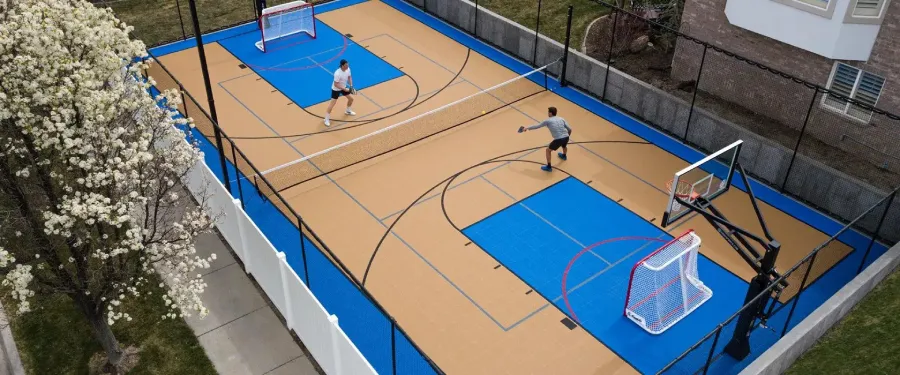
Racquetball Court
Rating: Playable, but the smaller size and enclosed space can make the game feel more intense and less traditional.
“Can you play pickleball on racquetball court?” – The answer is yes, it is possible to play pickleball on racquetball courts. Racquetball courts are usually found indoors, in enclosed areas with firm, smooth surfaces. Thus, they are ideal for serving as a makeshift pickleball court. A racquetball court’s normal measurements are 20 feet wide by 40 feet long. This measurement is smaller than that of a typical pickleball court.
This smaller size court may make the game feel faster and more intense. The surface of the racquetball court contributes to steady and stable ball bounces. Even so, the constrained area can make long rallies and powerful shots less effective. This causes play to become less traditional and more control-oriented.
Badminton Court
Rating: Playable with adjustments, but the softer surface and higher net may affect ball bounce and shot execution.
Pickleball is playable on badminton courts. Badminton courts are ideal for pickleball since their proportions are quite comparable to that of a regular pickleball court (20 feet wide by 44 feet long) but the ball bounce may be less predictable on badminton courts because they frequently have extra padding.
A pickleball net’s center is often 34 inches, whereas a badminton court’s net measures 61 inches. It could be more difficult to execute some shots, including smashes and volleys if the net isn’t lowered. In summary, while a badminton court can be a good substitute for a pickleball court, making the necessary adjustments is crucial to ensuring a proper game experience.
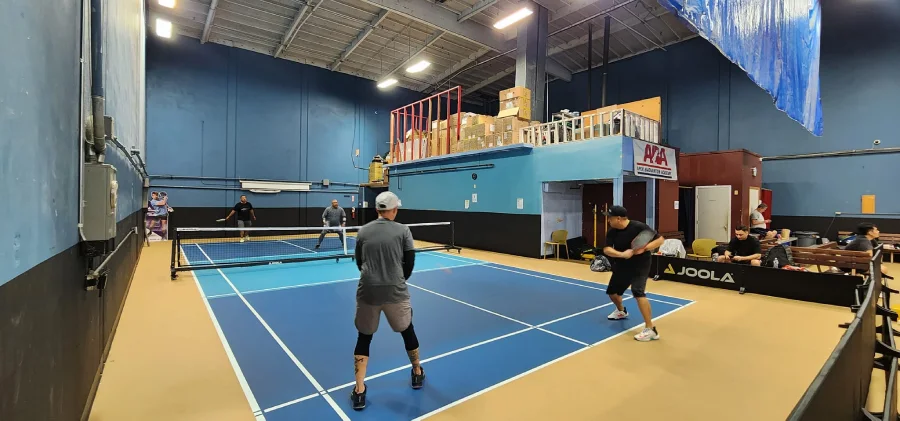
Regulations Standard Pickleball Courts
A standard pickleball court follows specific regulations to ensure consistency and fairness in play. If you’re just playing for fun, you might be unable to keep up with all these regulations. Yet I encourage you to them in place as much as possible.
- The dimensions of a standard court are 20 feet wide by 44 feet long. For singles and doubles, this size is the same.
- Non-volley zone (kitchen) extends 7 feet from the net on each side. Players are not allowed to volley (hit the ball in the air) while standing in this zone.
- Service courts are divided into left and right service courts, each measuring 10 feet wide by 15 feet long.
- The baselines run parallel to the net at the ends of the court, and the sidelines run perpendicular to the net. All lines on the court should be 2 inches wide and in a color that contrasts with the court surface.
- The net height is 36 inches at the sidelines and 34 inches at the center. The net divides the court into two halves and must be taut and anchored securely.
- Space around the court is recommended around all sides of the court at least 10 feet to ensure players move freely, safely, and without obstruction.
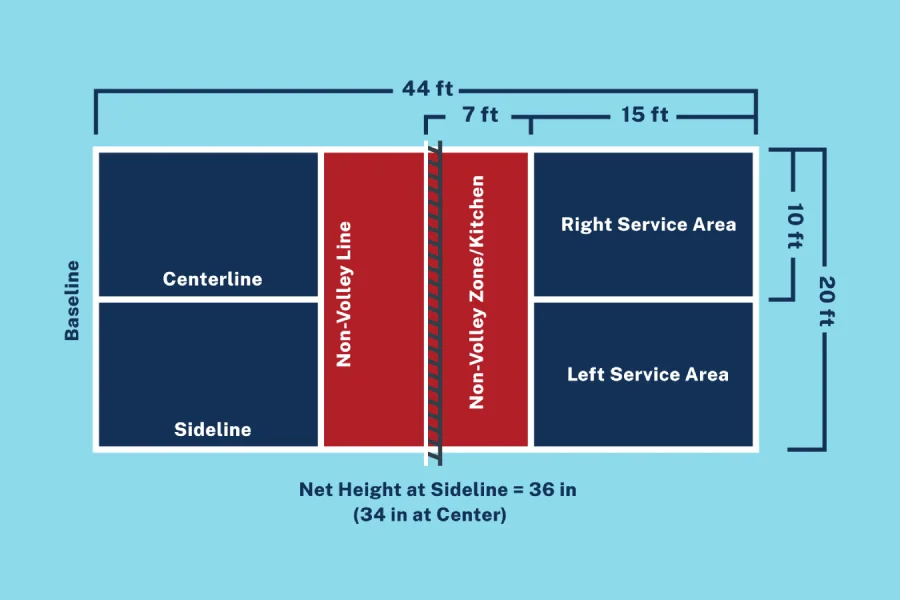
Final Thought
In conclusion, pickleball’s popularity has grown in part because of its versatility in locations, leaving many to wonder where can you play pickleball in their area. The game is available and welcoming to players of all skill levels, whether they are on multifunction courts or in specialized indoor spaces.
- Hard surfaces, such as concrete and asphalt, offer a higher and more consistent bounce, which improves speed and performance.
- Softer surfaces, such as grass or clay, produce a lower and less predictable bounce, thus lowering the game’s tempo. Playing in diverse weather and surface conditions creates new challenges and sensations.
Pickleball is not limited to dedicated courts. You may play this sport anywhere, from custom-built venues to professional courts. Over the years, I’ve played pickleball in many interesting locations, including the beach, the street, and even the garage. Each area has unique qualities that create diverse emotions in players.
Pickleball may be played anyplace. Yet a high-quality court with a level playing surface, a taut net, and ample room will help you advance your abilities and lower your chance of injury.
If you can’t find a suitable playground near your house, you may easily construct a little pickleball court at home or in your garden. You’ll save time traveling and have a private practice area as a result of this.
Above all, focus on safety at all times. You should always be mindful of your surroundings and abide by local laws when playing pickleball in public areas. Before playing, make sure you warm up properly and put on all necessary safety gear.


